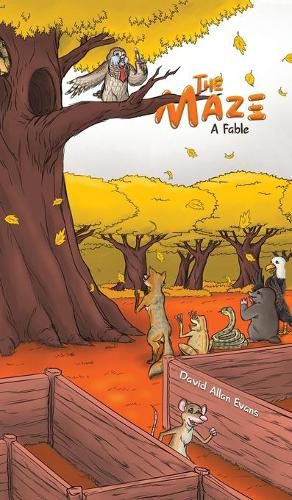Readings Newsletter
Become a Readings Member to make your shopping experience even easier.
Sign in or sign up for free!
You’re not far away from qualifying for FREE standard shipping within Australia
You’ve qualified for FREE standard shipping within Australia
The cart is loading…






This title is printed to order. This book may have been self-published. If so, we cannot guarantee the quality of the content. In the main most books will have gone through the editing process however some may not. We therefore suggest that you be aware of this before ordering this book. If in doubt check either the author or publisher’s details as we are unable to accept any returns unless they are faulty. Please contact us if you have any questions.
Like Aesop’s Fables and Orwell’s Animal Farm, The Maze is populated with animal characters who, in their words and actions, reveal truths about human nature. In The Woods, a very popular, clever, and ambitious rat named Sniff-who commands a pack of deputy rats known as The Five-intends to replace the aging leader, Owl, when he retires on election day in two weeks. As a famous athlete of the air in his youth, Owl has established The Tradition of Wings. In his speeches to the animals, Sniff-an assistant to Owl but already acting as if he’s the leader-promises to establish what he calls The Kingdom of Sharing, in which rats will be leaders and all other animals will be followers. Opposing Sniff’s rise to power are two winged animals-a well-known poet hawk, Wing, and his studious friend, Butterfly-and Claws, a young, robust, and competitive squirrel. The central image of the story is a maze. Sniff has one built ostensibly for community recreation but actually to make money and to display rats’ superiority as maze-runners. Other characters in this sometimes-humorous story include Spider, an architect; Snake, a shady character; Stub, a mole who assists Sniff; and Frog, an instructor of bug-catching. The Maze is not only about human nature but about animal life in general. It explores necessities of survival such as status and power, altruism and self-interest, the defense of territory, and the conquering of enemies through group cooperation.
$9.00 standard shipping within Australia
FREE standard shipping within Australia for orders over $100.00
Express & International shipping calculated at checkout
This title is printed to order. This book may have been self-published. If so, we cannot guarantee the quality of the content. In the main most books will have gone through the editing process however some may not. We therefore suggest that you be aware of this before ordering this book. If in doubt check either the author or publisher’s details as we are unable to accept any returns unless they are faulty. Please contact us if you have any questions.
Like Aesop’s Fables and Orwell’s Animal Farm, The Maze is populated with animal characters who, in their words and actions, reveal truths about human nature. In The Woods, a very popular, clever, and ambitious rat named Sniff-who commands a pack of deputy rats known as The Five-intends to replace the aging leader, Owl, when he retires on election day in two weeks. As a famous athlete of the air in his youth, Owl has established The Tradition of Wings. In his speeches to the animals, Sniff-an assistant to Owl but already acting as if he’s the leader-promises to establish what he calls The Kingdom of Sharing, in which rats will be leaders and all other animals will be followers. Opposing Sniff’s rise to power are two winged animals-a well-known poet hawk, Wing, and his studious friend, Butterfly-and Claws, a young, robust, and competitive squirrel. The central image of the story is a maze. Sniff has one built ostensibly for community recreation but actually to make money and to display rats’ superiority as maze-runners. Other characters in this sometimes-humorous story include Spider, an architect; Snake, a shady character; Stub, a mole who assists Sniff; and Frog, an instructor of bug-catching. The Maze is not only about human nature but about animal life in general. It explores necessities of survival such as status and power, altruism and self-interest, the defense of territory, and the conquering of enemies through group cooperation.